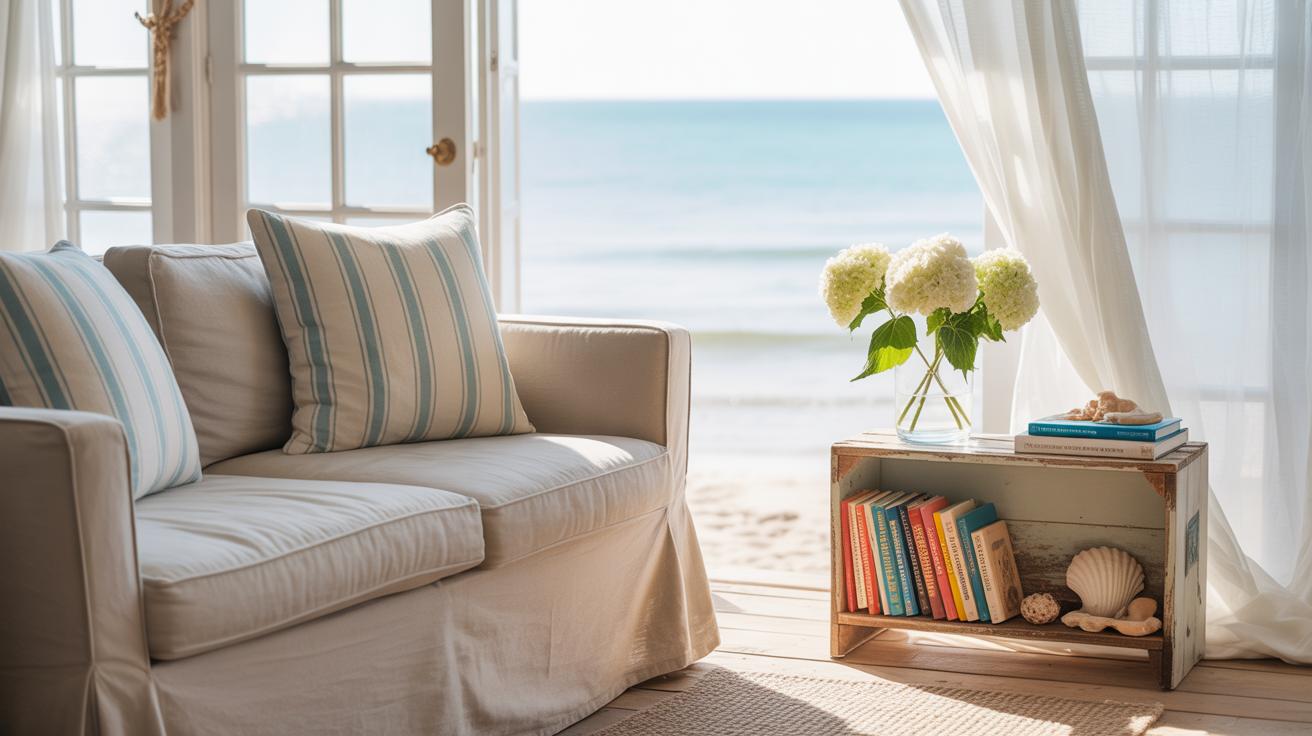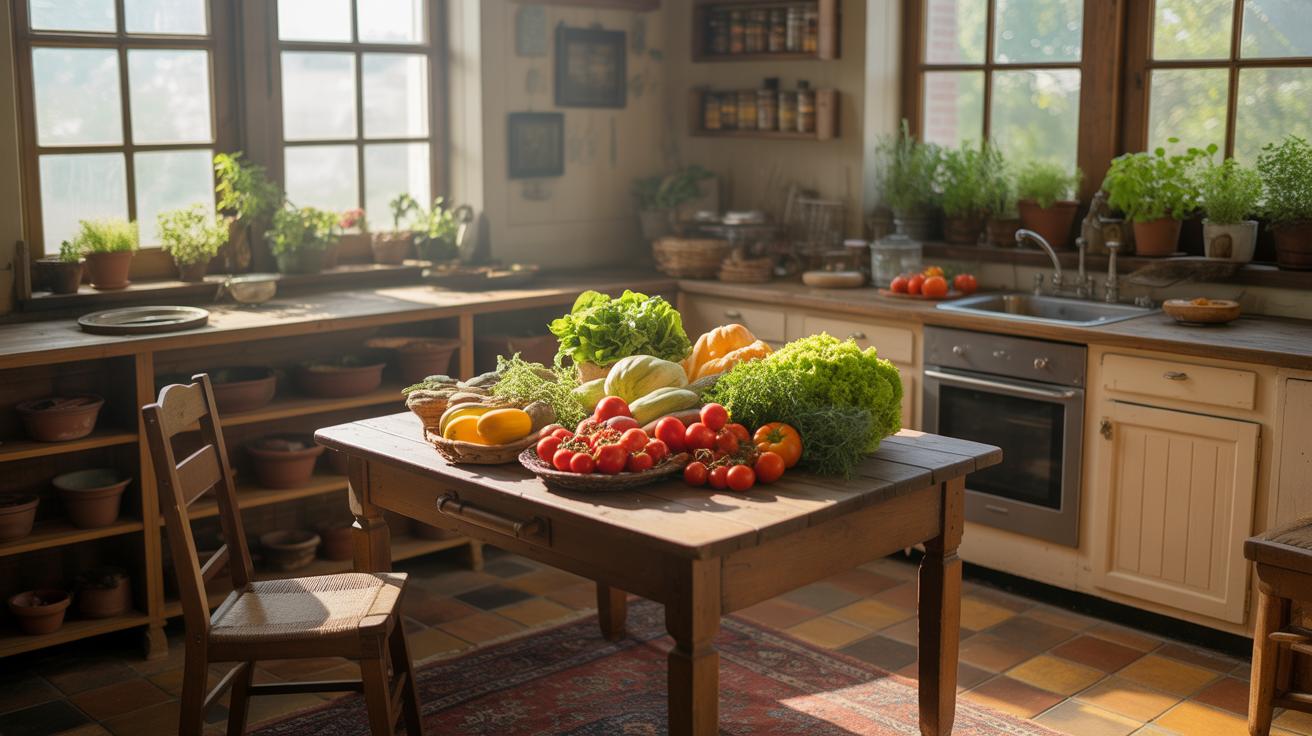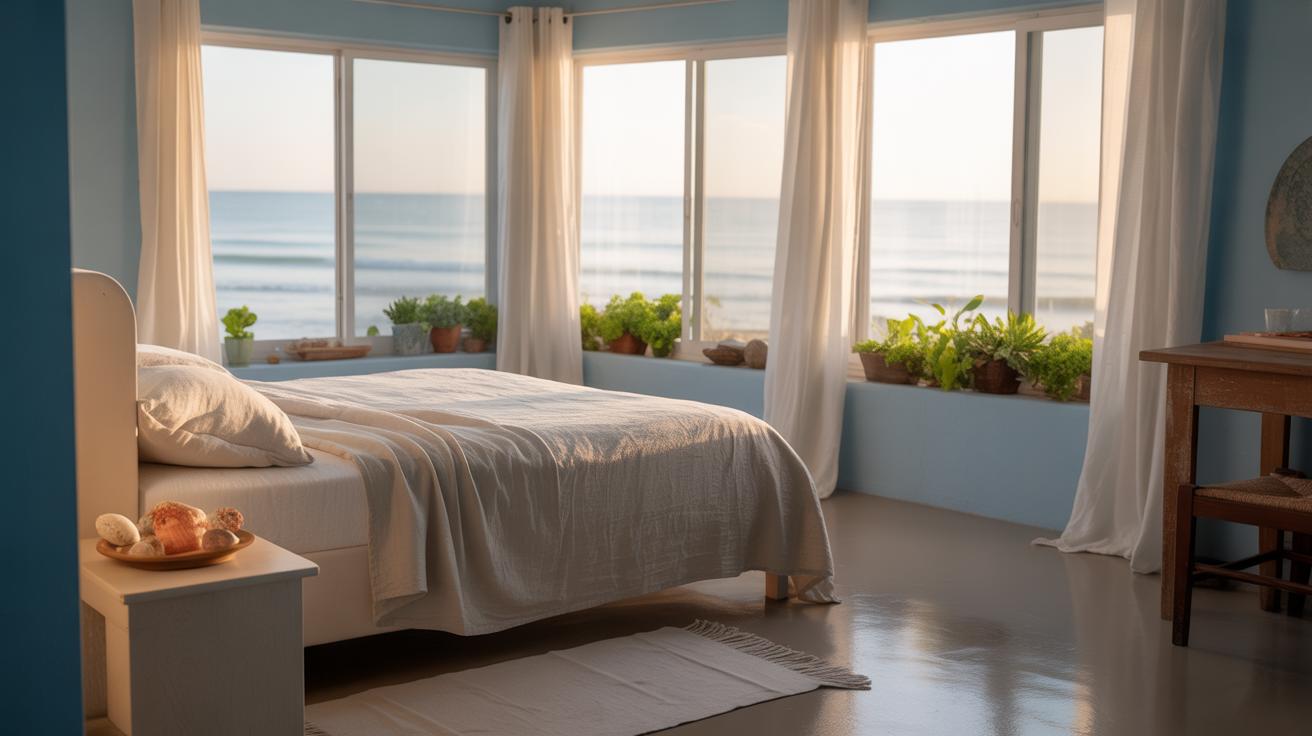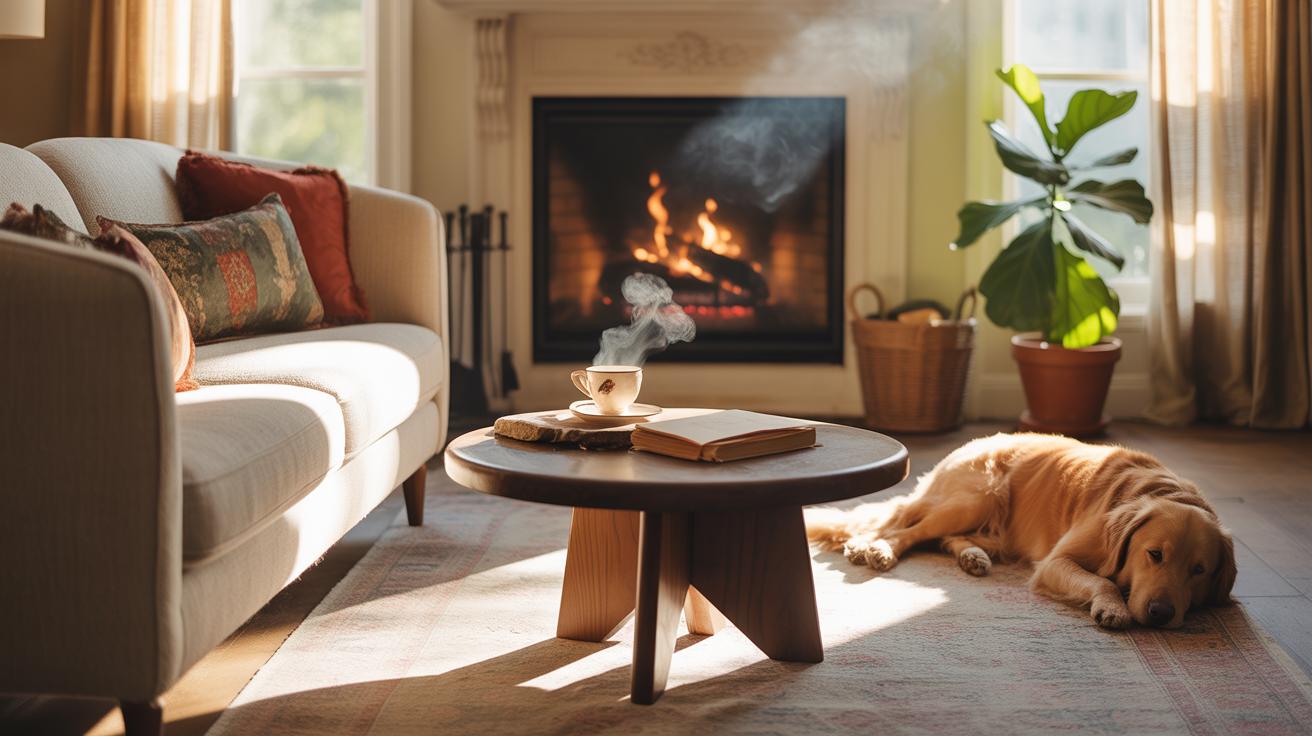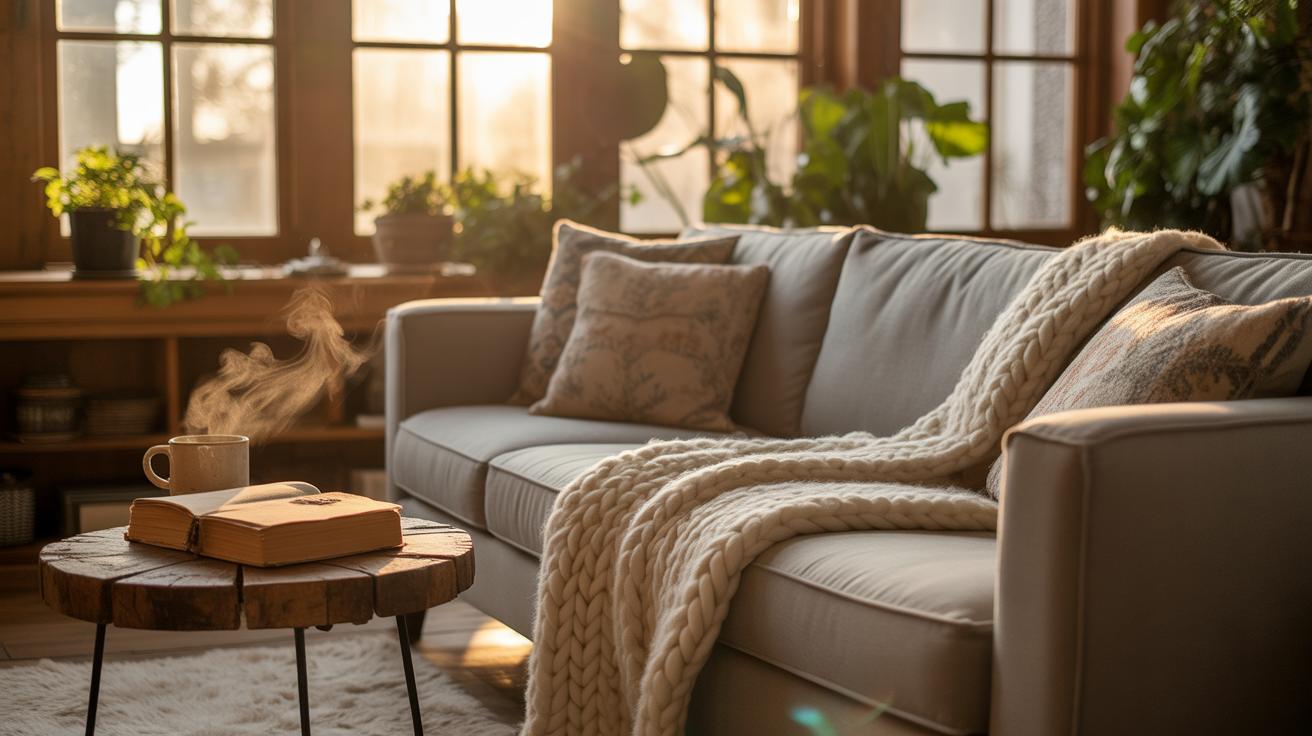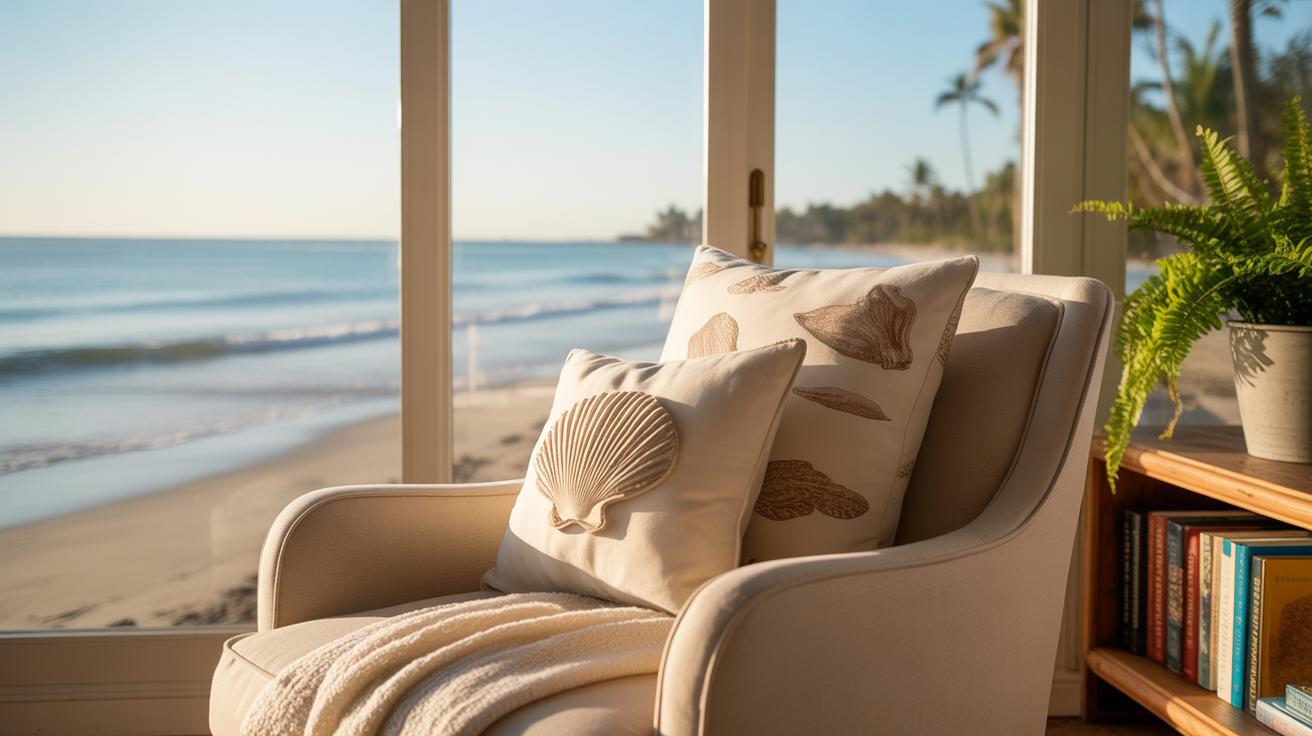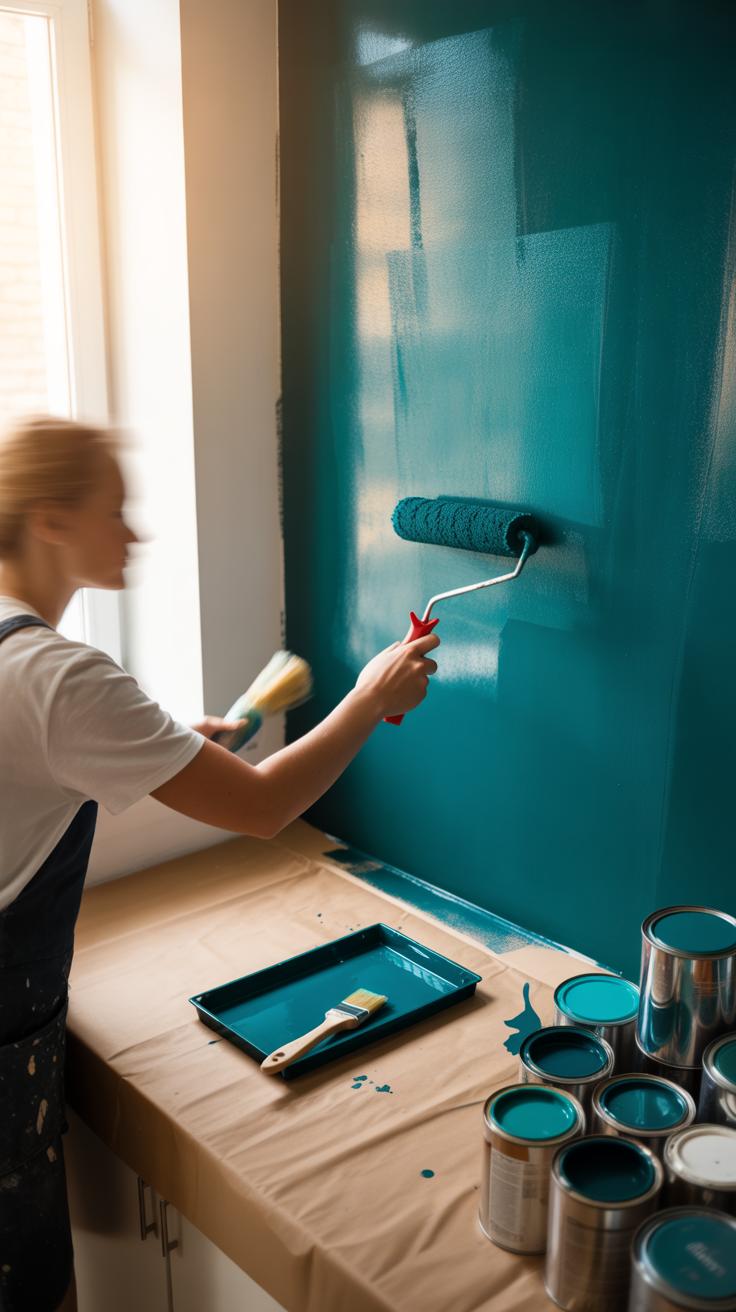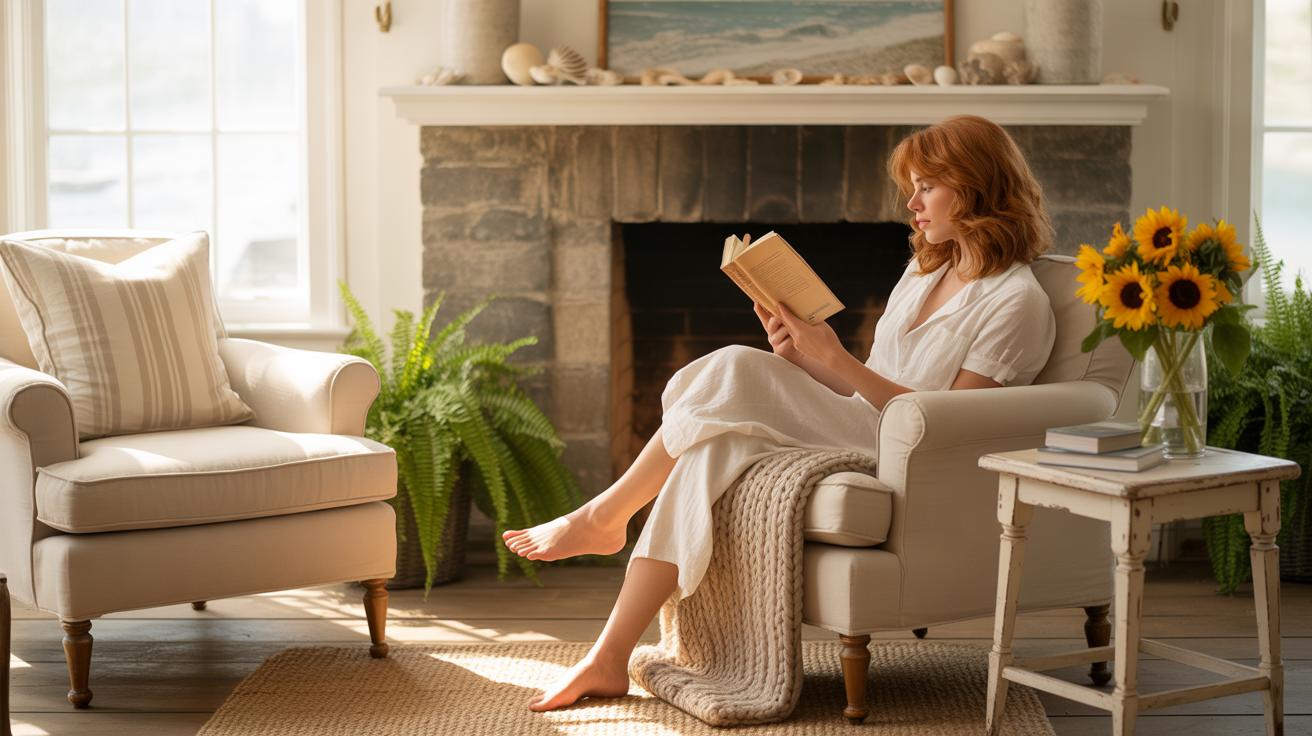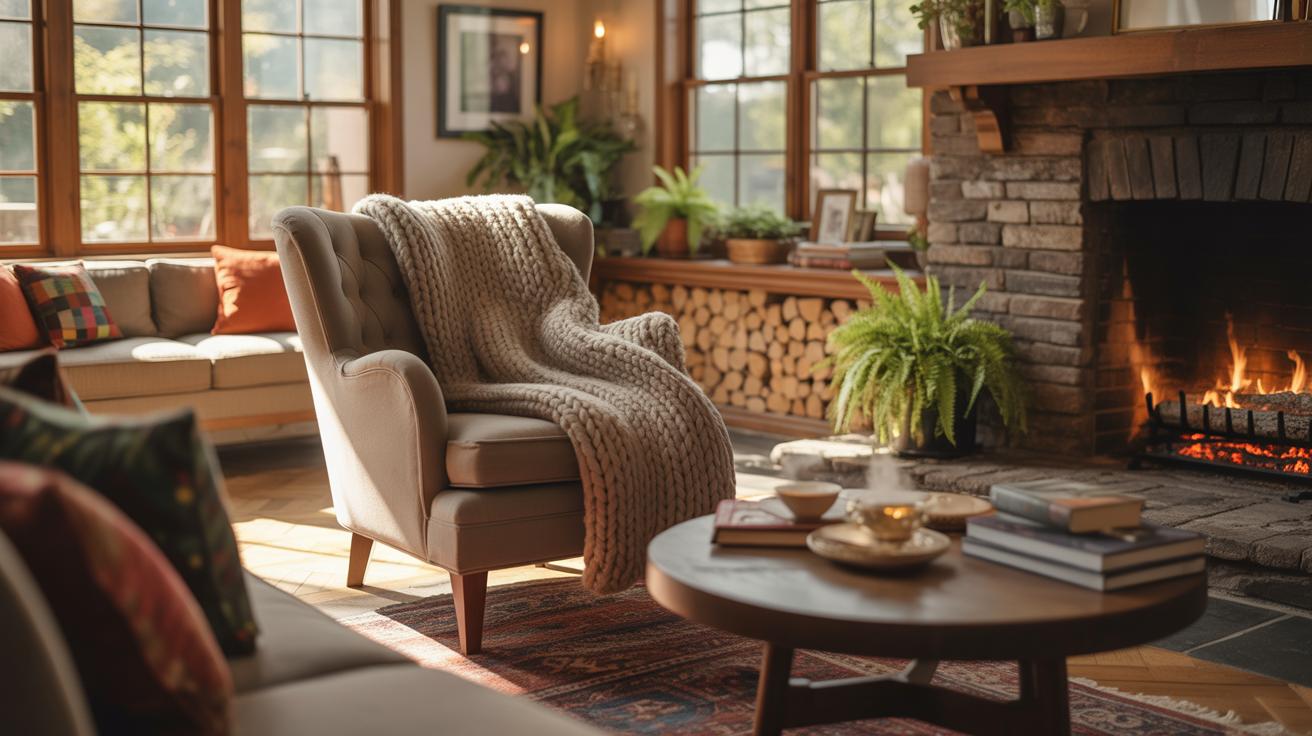Introduction
Beach cottage style captures the feeling of a peaceful retreat by the sea. This home decor style uses soft colors, natural materials, and simple designs to create a welcoming atmosphere. Whether you live near the coast or want to bring the ocean’s calm into your home, beach cottage style offers many ideas to explore.
In this article, you will discover practical ideas for decorating your home in beach cottage style. We’ll cover key elements like color choices, furniture types, and decorative accents. You will learn how to make your space feel airy, bright, and cozy with easy-to-follow tips and examples for your home projects.
Choosing Your Colors
When thinking about beach cottage color schemes, soft blues, whites, sandy neutrals, and pastels usually come to mind first. These colors don’t just fill a room; they seem to change its whole mood. Soft blues remind you a bit of the sea on a calm day—not too bright, but clear enough to feel open and airy. Whites act like a breath of fresh air. They bounce light around and make spaces feel breezy, clean, and, well, fresh. You might find yourself looking at a living room painted in pale blue with crisp white trim and wondering why you ever liked darker, heavier colors.
Soft blues and whites work especially well in bathrooms and bedrooms. Imagine a bedroom wall in a muted sky blue with white linens and accents—simple but refreshing. Or a kitchen painted in a faded blue with white cabinets, which can brighten up the whole cooking area without making it feel stark. These colors often reflect natural light beautifully, which could make you question if you need extra lighting at all. At least during the day.
Pastels and neutral tones add a layer of subtlety to beach cottage palettes. Think pale coral, seafoam green, or light sandy beige. These shades soften the blue-and-white contrast and create balance. When used on furniture, curtains, or smaller decor pieces, they bring warmth without overwhelming the calmness. Here are some colors you could test:
- Soft peach or coral for occasional chairs or throw pillows
- Seafoam or mint green on smaller walls or trims
- Beige and creamy neutrals as main background tones on walls or rugs
When you bring these colors together, the space may start feeling rather soothing, even peaceful. But sometimes, that can also make a room feel a bit…flat or uninspired if you’re not careful. So, mixing these tones with textures and natural light is where it really takes shape. Do you find certain color combos make you linger longer in a room? I do. And that’s the little magic of choosing the right colors.
Selecting Furniture
Furniture in a beach cottage should feel easy and unforced. Think simple lines, relaxed shapes, and pieces that invite you to kick back. Comfort matters just as much as style, maybe more. You want to sit down and not want to get up—without the fuss of overly formal or ornate designs.
Natural wood furniture fits this vibe surprisingly well. Woods like pine, oak, or cedar work beautifully. They bring warmth and a subtle texture that doesn’t scream for attention but rather folds into the room gently. Sometimes the finish is rougher or weathered, which adds character—and if you’ve ever seen a sun-bleached driftwood table, you know why that feels just right here.
On the other hand, lightly painted furniture can soften a space noticeably. Whitewashed dressers and soft blues or pale greens offer a touch of color without overwhelming the calm feeling. Think about cottage-style pieces with a slightly distressed finish; they almost tell a story while staying understated. You might find yourself drawn to pale hues like seafoam, cream, or even muted coral.
There’s something about function, too. You might want storage benches that double as extra seating or a simple coffee table with open shelves. These choices emphasize utility without sacrificing the relaxed, welcoming mood that defines beach cottages. So, what pieces would you want to live with every day—ones that feel like they belong to the gentle rhythm of coastal life?
Incorporating Textiles
When it comes to textiles in a beach cottage style, linen and cotton are often the best bets. These fabrics feel light and airy, which suits a coastal vibe perfectly. You might notice linen’s slightly rougher texture compared to cotton’s smoothness, but both breathe well. That’s key, especially in warmer months or more humid spaces—fabrics that just trap heat wouldn’t do.
Lightweight materials tend to wear well, too, especially when you’re aiming for casual comfort rather than something fussy. Adding pillow covers or curtains in these fabrics lets your home feel relaxed, not stiff. Patterns like classic stripes—think navy and white or sandy beige—bring in that subtle beach feel without screaming for attention.
Florals, on the other hand, offer a softer touch. They can be a bit more traditional, but when kept small-scale or in faded pastels, florals blend easily. Mixing stripes and florals sounds risky, but it works if you’re careful with color coordination and avoid too many busy prints at once. Solid colors then act like a visual rest, balancing the eye.
The benefits of natural fabrics are hard to overlook. They’re breathable, yes, but they also develop a texture that feels lived-in over time, almost like a quiet story of many beach weekends. Cleaning them can be surprisingly straightforward, especially if you stick with lighter shades that show less wear.
What I find tricky is deciding how much pattern to use. Are you someone who likes a lot of visual energy, or do you prefer to keep surfaces calm? Maybe experiment with a few throw pillows or chair covers first—see how stripes and florals can either clash or complement your space. It’s a subtle art, figuring out when patterns add character versus when they just clutter a small room.
Using Decorative Accents
Natural Items
Shells and driftwood belong at the heart of beach cottage decor, but it’s easy to go overboard and suddenly feel like you’re living in a souvenir shop. Finding a balance matters. Try grouping a handful of shells in a shallow glass bowl instead of scattering them everywhere. Driftwood can be striking, especially when used as part of a centerpiece or mounted as wall art. Sometimes, just one well-chosen branch can bring that earthy coastal vibe without cluttering your space.
Display matters too. Placing natural items on open shelves or in clear jars adds texture but keeps the look light and approachable. You might want to toss a few tiny shells into your soap dish or use driftwood base lamps for subtle accents. It’s about weaving these elements quietly around your room rather than shouting with them.
Coastal Art and Accessories
Coastal artwork can instantly pull a space together, but I think the key lies in picking pieces that feel authentic, not forced. Prints of sea life, soft watercolor landscapes, or even weathered signs with nautical themes add personality. You don’t need a wall of art either. Sometimes a single framed print or a simple coastal-inspired mirror can make more impact than overcrowding walls.
Accessories like coral-shaped candleholders, rope-wrapped vases, or ceramic fish sculptures offer small touches of the sea without taking over. Think about objects that speak to your personal connection with the coast rather than just ticking a box. Ask yourself: does this benefit the room’s feel or just fill the space?
Ultimately, using these accents thoughtfully makes your home feel beach-adjacent rather than beach-overdone.
Lighting Your Space
Lighting really shapes how a beach cottage feels. It’s more than just brightness—it sets the mood. Soft, warm light tends to make spaces feel inviting and airy, which is exactly the vibe you want by the coast. Harsh or overly bright white lights can kill that relaxed feeling and make everything seem a bit too artificial.
To keep that natural, easy glow, think about sources that emit a gentle warmth. Lamps with fabric shades, for example, diffuse light softly. String lights, especially those with small bulbs, add a casual charm. You might notice how dimmers change the atmosphere completely—flipping a switch and watching the room go from lively to calm almost feels like magic.
Natural Light Maximization
Windows are your best ally here. Bigger windows—or even french doors—pull the outside in and flood rooms with daylight. When choosing curtains, go for sheer or lightweight fabrics that let sunlight filter through. Heavy drapes can block too much light and weigh down the space, which tends to conflict with the airy feel you want.
Sometimes, it’s tempting to grab bold, decorative curtains for character, but it’s better to keep those minimal or use natural tones. You want sunshine to bounce around freely. Mirrors opposite windows help, too—they reflect light and make rooms seem bigger and brighter. Simple tricks, yes, yet effective.
Soft Artificial Lighting
Beyond daylight, lamps provide warmth and form. A table lamp with a warm bulb near a cozy chair encourages reading and relaxation. Floor lamps that angle light upward can soften shadows without glaring. Then there are string lights—often overlooked, but they add a subtle twinkle perfect for evenings.
Using bulbs with a color temperature around 2700K usually hits the sweet spot—it’s warm but not too orange. Avoid bright, cool white bulbs that feel clinical. Also, installing dimmers wherever possible gives control over light levels. Sometimes, you want things bright. Other times, softer lighting helps you wind down.
Lighting choices aren’t just practical; they physically and emotionally influence how your space feels. When done thoughtfully, light can make your beach cottage more than just a place to live—it becomes a haven.
Floor and Wall Ideas
When shaping a beach cottage vibe, your choice of floors and walls makes a big difference. Wood floors are pretty central here. They bring warmth and natural texture that feels just right—like you’re still connected to the outdoors, even inside. I’ve found that softer wood tones, like weathered pine or white oak, often work best. They don’t dominate the space but add an earthy, grounded feel. If bare wood feels too cold, layering with area rugs is an easy fix.
Speaking of rugs, go for natural fibers like jute, sisal, or cotton. They complement the wood nicely but add softness underfoot. Colors in muted blues, sandy beiges, or pale grays enhance that beachy atmosphere without clashing. Of course, you could pick a bolder, patterned rug if you want a pop of personality—it all depends on how neutral or lively you want your space to feel.
Walls can be a little tricky since they’re such a huge visual element. Beadboard is kind of a classic here. It adds texture, a subtle nod to cottage nostalgia, and breaks up blank surfaces that otherwise might feel too plain. You don’t need to cover every wall—just one accent wall or halfway up the room often looks best. I’ve installed beadboard in a guest room before, and it instantly felt more cozy but still fresh.
Paint or wallpaper options that stay light and soft are key. Pale shades of blue, seafoam green, cream, or very light gray keep rooms feeling open and bright. If you want wallpaper, something with a subtle pattern—maybe a delicate stripe or a faint coral motif—can work well without overwhelming the senses. If you’re not sure about wallpaper, trying removable versions first could be less intimidating.
Creating Outdoor Spaces
Designing an outdoor area that fits the beach cottage style means leaning toward simplicity and lightness, yet durability tends to sneak in as a priority. For your patio or porch, think about furniture made from materials like teak, weather-resistant wicker, or painted metal. These options hold up well in salty air but don’t look too heavy or harsh—something you’d want to sit on while sipping lemonade and watching waves, maybe.
Picking pieces in pale tones—whites, soft blues, or sandy beiges—helps keep the look fresh and calm. A few cushioned chairs or a bench with washable fabric can soften the space. Don’t shy away from a little imperfection or wear; that’s part of the charm. Just avoid anything oversized or dark that disrupts the open, airy vibe.
When it comes to plants, coastal varieties like sea oats, lavender, or ornamental grasses fit in perfectly. They bring texture but aren’t too fussy—usually drought-tolerant, which is a bonus since beach homes often get windy and a bit dry. Potted succulents or even small palms can thrive outside, given proper sun and occasional watering, which might be easier than you think if you find the right balance.
Accessories round out the feel. Layer in woven baskets, simple lanterns for evening light, or small driftwood accents. Maybe an old rowboat oar leaned in the corner, or glass jars filled with shells you collect during walks. These details don’t have to be perfect; often, their casual, slightly weathered look adds character. What’s tempting to me is mixing functional items with decorative ones that invite you to linger, stare out, simply be.
Maintaining Your Style
Keeping your beach cottage decor looking fresh does take some effort, but it doesn’t have to be a big chore every time. Simple cleaning routines can really make a difference. For wooden furniture, wipe down surfaces regularly with a slightly damp cloth to remove dust and salt residue, which can dull the finish over time. Avoid harsh chemicals that might strip away the charm you worked hard to create.
Fabric pieces like cushions or slipcovers often catch sand and dirt. You might try spot cleaning small stains with mild soap and water, or toss removable covers in the wash if possible—but be gentle. Some natural fibers can shrink or lose their texture if washed too aggressively.
When it comes to decor items—think shells, glass, or wicker—regular dusting is key. A soft brush works well for intricate shapes, keeping them vibrant without wearing them down. Small repairs here and there help too, like tightening loose screws in chairs or refreshing chipped paint, which keeps things feeling cared for and cozy.
Adjusting your look with the seasons can keep the beach cottage vibe from feeling stale. In warmer months, you might lean into lighter blues and sandy tones with airy curtains or lighter throws. Fall and winter can welcome subtle warming touches—maybe deeper navy pillows or woven textures that add warmth without drifting too far from the coastal feel.
Does your color palette feel too fixed? Swapping a few throw pillows or adding fresh greenery can breathe new life into a room without an overhaul. The key is to keep the core style constant—just give it small nudges here and there. This way, your space grows with the seasons, but never loses that comfortable beachy charm you treasure.
Conclusions
Beach cottage style embraces comfort and simplicity. Using light colors, natural textures, and thoughtful decor, you can create a relaxing seaside environment in your home. The style helps you feel connected to nature while enjoying casual, inviting rooms.
By applying the ideas discussed, your home will reflect calm and charm. The beach cottage look suits many rooms and budgets. With a few changes, you can make your space a personal coastal haven that welcomes you every day.

